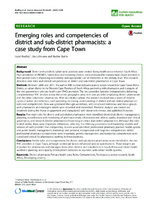| dc.contributor.author | Bradley, Hazel A. | |
| dc.contributor.author | Lehmann, Uta | |
| dc.contributor.author | Butler, Nadine | |
| dc.date.accessioned | 2016-01-11T09:49:51Z | |
| dc.date.available | 2016-01-11T09:49:51Z | |
| dc.date.issued | 2015 | |
| dc.identifier.citation | Bradley, H., et al., (2015). Emerging roles and competencies of district and sub-district pharmacists: a case study from Cape Town. Human Resources for Health, 13:88 | en_US |
| dc.identifier.issn | 1478-4491 | |
| dc.identifier.uri | http://hdl.handle.net/10566/2053 | |
| dc.description.abstract | District and sub-district pharmacist positions were created during health sector reform in South Africa.
High prevalence of HIV/AIDS, tuberculosis and increasing chronic non-communicable diseases have drawn attention to
their pivotal roles in improving accessibility and appropriate use of medicines at the primary level. This research
describes new roles and related competencies of district and sub-district pharmacists in Cape Town.
Between 2008 and 2011, the author (HB) conducted participatory action research in Cape Town Metro
District, an urban district in the Western Cape Province of South Africa, partnering with pharmacists and managers of
the two government primary health care (PHC) providers. The two providers function independently delivering
complementary PHC services across the entire geographic area, with one provider employing district pharmacists
and the other sub-district pharmacists. After an initiation phase, the research evolved into a series of iterative
cycles of action and reflection, each providing increasing understanding of district and sub-district pharmacists’
roles and competencies. Data was generated through workshops, semi-structured interviews and focus groups
with pharmacists and managers which were recorded and transcribed. Thematic analysis was carried out
iteratively during the 4-year engagement and triangulated with document reviews and published literature.
Five main roles for district and sub-district pharmacists were identified: district/sub-district management;
planning, co-ordination and monitoring of pharmaceuticals; information and advice; quality assurance and clinical
governance; and research (district pharmacists)/dispensing at clinics (sub-district pharmacists). Although the roles
looked similar, there were important differences, reflecting the differing governance and leadership models and
services of each provider. Five competency clusters were identified: professional pharmacy practice; health system
and public health; management; leadership; and personal, interpersonal and cognitive competencies. Whilst
professional pharmacy competencies were important, generic management and leadership competencies were
considered critical for pharmacists working in these positions.
Similar roles and competencies for district and sub-district pharmacists were identified in the two
PHC providers in Cape Town, although contextual factors influenced precise specifications. These insights are
important for pharmacists and managers from other districts and sub-districts in South Africa and inform health
workforce planning and capacity development initiatives in countries with similar health systems. | en_US |
| dc.language.iso | en | en_US |
| dc.publisher | BioMed Central | en_US |
| dc.source.uri | http://dx.doi.org/10.1186/s12960-015-0081-8 | |
| dc.subject | District pharmacist | en_US |
| dc.subject | Primary health care | en_US |
| dc.subject | Participatory action research | en_US |
| dc.subject | South Africa | en_US |
| dc.subject | Developing country | en_US |
| dc.subject | World Health Organisation (WHO) | en_US |
| dc.subject | Pharmacists | en_US |
| dc.subject | Cape Town | |
| dc.title | Emerging roles and competencies of district and sub-district pharmacists: a case study from Cape Town | en_US |
| dc.type | Article | en_US |
| dc.privacy.showsubmitter | false | |
| dc.status.ispeerreviewed | true | |
| dc.description.accreditation | Web of Science | en_US |

